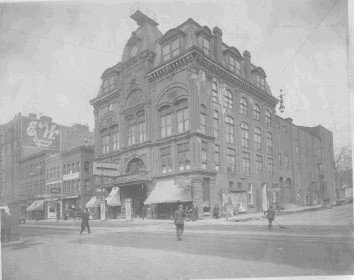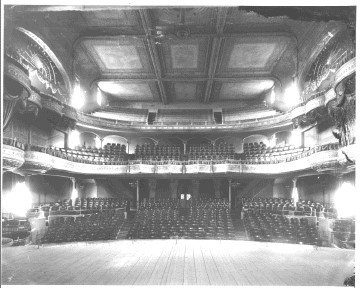Theatre
In the early days of Sioux City, entertainment consisted of social gatherings with friends such as dances and picnics. In 1870 the Academy of Music was constructed and opportunities began to improve. The four-story building housed the post office and other government and commercial offices on the first floor with the Academy Performing Hall located on the second and third floors.
Located on the south side of Fourth Street between Douglas and Pierce streets, the building was ninety feet wide and one hundred feet deep. The stage was twenty-two feet by fifty feet, with a twenty-six-foot arched opening. The stage had two trap doors for special effects and gas footlights which could be adjusted. Eight hundred people could watch shows performed by traveling companies. It was also used for high school graduations, political speeches, and concerts. Susan B. Anthony spoke on women's suffrage twice during the 1870s.
Although the Academy was a fine addition to Sioux City, many top companies would still not come to the city. The stage was too small for their productions and the audience capacity of 800 was not big enough. A new theatre was planned by the leaders of the community: the Peavey Grand Opera House.
By selling stock, money was raised by the citizens for a new building. Located at the corner of Fourth and Jones, the total building costs were raised several times. Each time citizens came forward until the final thirty thousand dollars needed for completion could not be raised. Construction stopped for seven months and finally, the money was raised. Several of the city's industrialists paid for the rest including: J. F. Peavey, Wm. Joy, James Booge, and A. S. Garretson.
The Chamber of Commerce, banks, and other businesses were housed in the front of the building. The theatre seating was divided into three areas with a combined seating of seventeen hundred seats. The five hundred seats in the gallery were the "cheap seats". Costing only seventy-five cents, this area had a separate entrance on the side of the building and ticket holders were not allowed to use the indoor plumbing.
The Peavey Grand Opera House was built with the finest materials available. Carpeting, silk curtains, stained glass doors, windows draped with French tapestry, and lace curtains were just some of the best qualities of the building.
The Peavey Grand Opera House was a huge success. The most famous companies and actors in the country all came to Sioux City to perform. These included:
Edwin Booth and Lawrence Barnett in "Hamlet"
Maude Adams in "The Midnight Bell"
Milton and Dolly Nobles
Sarah Bernhardt in "Camille"
Broadway shows directly from New York like "The Old Homestead" and "Way Down East"
The Peavey Grand Opera House continued on until it closed in 1919. It was later used as a warehouse and the stage became an auto repair shop. The building caught fire in 1931 and had to be torn down. This ended a glorious piece of the city's theatrical history.




